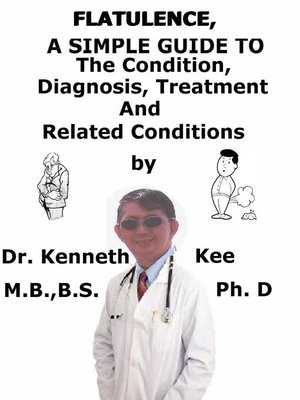Flatulence, a Simple Guide to the Condition, Diagnosis, Treatment and Related Conditions
ebook
By Kenneth Kee

Sign up to save your library
With an OverDrive account, you can save your favorite libraries for at-a-glance information about availability. Find out more about OverDrive accounts.
Find this title in Libby, the library reading app by OverDrive.



Search for a digital library with this title
Title found at these libraries:
| Library Name | Distance |
|---|---|
| Loading... |
This book describes Flatulence, Diagnosis and Treatment and Related Diseases
It is natural to have intestinal gas, and to pass gas by the rectum (flatus) is very frequent.
Flatulence happens in the average person about 20 times a day.
The volume within the normal range (in studies that have looked at this) is anywhere from 200 cc to 2000 cc of rectal flatus.
Also known as farting, passing wind, or having gas, flatulence is a medical term for releasing gas from the digestive system through the anus.
It happens when gas accumulates inside the digestive system, and is a normal process.
People fart (pass gas by the rectum) on average 20 times per day at 7mph.
In many cultures, flatulence in public is regarded as embarrassing, but, depending on context, can also be considered humorous.
People will often strain to hold in the passing of gas when in polite company, or position themselves to silence the passing of gas.
In other cultures it may be no more embarrassing than coughing.
Flatulence is often blamed as a significant source of greenhouse gases, owing to the erroneous belief that the methane released by livestock is in the flatus
The New Zealand government is a signatory to the Kyoto Protocol and therefore attempts are being made to reduce greenhouse emissions.
To achieve this, an agricultural emissions research levy was proposed, which promptly became known as a "fart tax" or "flatulence tax"
Gas accumulates in 2 main ways:
1. Swallowing air while the person eats or drinks can cause oxygen and nitrogen to collect in the digestive tract.
2. Digestive gases such as hydrogen, methane, and carbon dioxide collect during digestion of food.
Either way can produce flatulence.
Flatulence is due to the production of gas by bacteria within the intestines (normally the colon) when they digest dietary sugars and polysaccharides that enter the colon undigested.
The excessive production of gas and increased flatulence may happen due to:
1. The higher capability of some bacteria to form gas,
2. Mal-digestion or mal-absorption of sugars and polysaccharides such as that seen in chronic pancreatitis with pancreatic insufficiency, and celiac disease, and
3. Bacterial overgrowth of the small intestine.
Abdominal pain is not a frequent symptom of people with excessive gas while the discomfort of flatulence may be depicted as pain.
The treatments for excessive gas are intestinal changes in diet and suppression of intestinal bacteria that produce the gas.
Foul-smelling gas (flatus) is not the same as excessive intestinal gas.
The foul smell of flatus happens from the types of food that are eaten and the types of gas produced by the bacteria in the colon, mostly gas that contains sulfur.
Over 90% of wind in the gut is made up of five gases: nitrogen, oxygen, carbon dioxide, hydrogen and methane.
The remaining 10% contains small amounts of other gases.
Most of these gases are absorbed into the blood stream and eventually excreted in the breath but the rest is passed as flatus.
If the diet does not contain a large quantity of carbohydrates or sugars, and the person does not swallow excessive air, the excessive flatulence may be caused by a medical disorder.
One frequent cause of flatulence is constipation
Food Intolerance may also cause flatulence.
Raised intestinal gas is not produced by irritable bowel syndrome (IBS) or most parasitic or bacterial intestinal infections.
Flatulence also is not produced by gastritis, gastric cancer, gallstones, cholecystitis, and pancreatitis or cystic fibrosis (unless there is...







